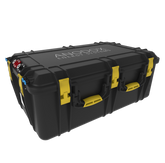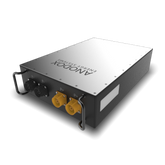FROM HYPER-CARS TO MEGA-FACTORIES
SAMPLE IMAGE GALLERY
As Anodox moves towards establishing a production line of high performance energy systems in Sweden, the team has been reflecting on the lessons learnt from a variety of challenging automotive projects with global automotive marques, who are innovating in the fast growing Electric Vehicle (EV) market.
In particular, Anodox gained great experience from the hyper-car market that will transfer into scaling up its battery business. Several recent hypercars use a hybrid drivetrain, a trend started in 2013 by the McLaren P1, Porsche 918 Spyder, and LaFerrari, then continued in 2016 with the Koenigsegg Regera, in 2017 with the Mercedes-AMG One, and in 2019 with the Ferrari SF90 Stradale and McLaren Speedtail. Anodox had the honour to participate in the development of full electric hyper-cars including Pininfarina Battista, Rimac Nevera, and Lotus Evija.
Several lessons can be transferred from the hyper-car world into Anodox as it scales from small scale battery assembly to operating a pan-European production. For example:
- Maintaining vibrant multicultural relationships with suppliers across continents and having a hands-on approach to delivering results are vital.
- Local sourcing can reduce the vulnerabilities and logistics costs associated with long supply chains.
- Margin comes from watching all business aspects like a hawk without losing sight of strategic objectives.
- 3D printing in design, development and small series production gives flexibility and speed. Staying on top of new tools and techniques in 3D printing is a critical ingredient for success.
For all OEMs and markets the net-zero agenda is pushing forward increasingly stringent emissions legislation (CO2, NOx). A key challenge for the industry is to make the right powertrain and technology choices in vehicles of all shapes and sizes. Some of the problems being solved in high end automotive can definitely trickle down into the mainstream.
As auto makers speed up their transition to electrification, they need to contend with three key issues:
- ICE (internal combustion engine) technology continues to develop and will not be phased out overnight.
- Society’s demands for mobility are changing rapidly due to demographic shifts and increased urbanisation.
- Governments are providing ever more challenging targets, complicated incentives and disincentives.
There are common trends worldwide in electrical and mechanical systems. Within electrical systems, the success of Tesla in the past 3-4 years and the roll out of ever increasing EV models from mainstream manufacturers show that the future is already here but not evenly distributed. In almost every case the Achilles Heel is the battery system. Immersion cooling approaches used in high performance EVs could become mainstream if engineered for the right cost/benefit ratio.
Given the dependency on rare earth minerals and environmentally-expensive materials, protecting the value of batteries across multiple life cycles is critical. Anodox battery packs are cell agnostic and can use new cell technologies once they are ready for the market. Until then there is an economic imperative to extend the life of the battery as much as possible. Here Anodox’s innovative cooling techniques and highly serviceable designs will make their batteries a great fit for 2nd life applications.
The current fossil-fuel price environment has an accelerating effect on the take-up rate of EVs. If prices continue to rise, the economics of electrification become simple. For example, the payoff of having a full electric truck may make it economical to convert fleets mid-life.
The light-weighting of vehicles is being increasingly deployed to help increase fuel efficiency and is critical for the success of global scale electrification. There is much to be learnt from high performance vehicle design regards 3D-printed nylon carbon fiber for bracketry, fasting points, and fixing points around the car.
Battery factories are important cornerstones for the dynamic growth in the market. Much is being made of gigafactories from NorthVolt, AKASOL, Freyr and others. Despite the difficulties associated with the coronavirus pandemic, these firms are managing to complete innovative and exemplary construction projects in record time.
These new production facilities will open a new era of serial production for lithium-ion battery modules and systems. Ongoing growth in the degree of automation is an important factor in the effort to meet increasing demand for battery systems.
Battery modules and battery systems alike will be manufactured using highly automated processes running in a modern and fully networked smart factory. However, the scale of gigafactory operations are sub-optimal for serving the niche markets where Anodox is focussed. Therefore, the firm’s mission is to build megafactories rather than gigafactories. Given the spiralling costs of logistics, this approach has particular relevance to the fast growing battery industry.
Transportation waste can increase the cost of anything that is required for manufacturing and assembly. It is not only found in production, but also throughout the supply chain, in offices and in sales. Transportation and warehousing are necessary activities but they do not add value to the end product. Anodox aims to reduce this type of waste by building in different strategic locations.












